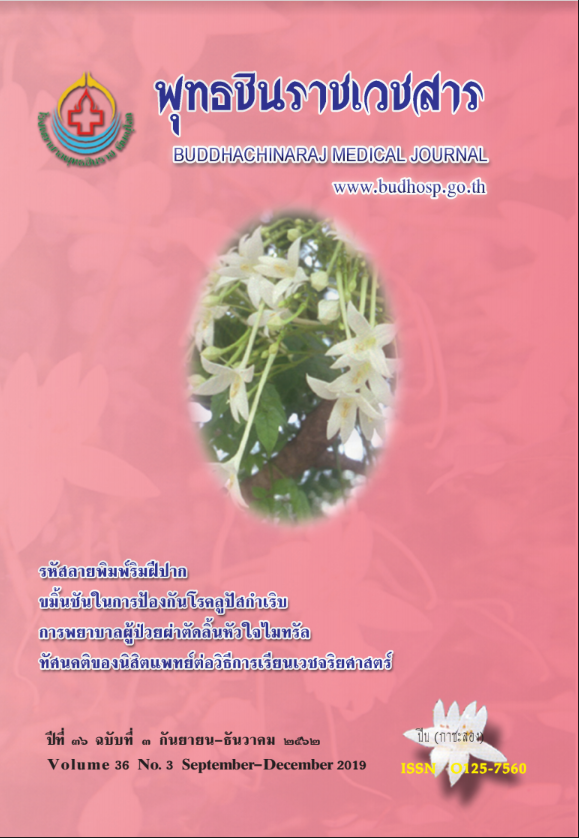ปัจจัยการรอดชีวิตของผู้ป่วยช่องทางด่วนอุบัติเหตุ
ปัจจัยการรอดชีวิตของผู้ป่วยอุบัติเหตุ
คำสำคัญ:
ปัจจัยการรอดชีวิต, ผู้ป่วยอุบัติเหตุ, ช่องทางด่วนอุบัติเหตุ, ห้องฉุกเฉินบทคัดย่อ
อุบัติเหตุเป็นสาเหตุของการเสียชีวิตที่พบบ่อย ถ้าทราบปัจจัยการรอดชีวิตน่าจะช่วยป้องกันการเสียชีวิตได้
การวิจัยนี้มีวัตถุประสงค์เพื่อวิเคราะห์ปัจจัยการรอดชีวิต ผลการดูแลรักษาผู้ป่วยช่องทางด่วนอุบัติเหตุ และ
เปรียบเทียบการรอดชีวิตระหว่างระยะเวลาที่ได้ผ่าตัดและส่งต่อ ศึกษาข้อมูลย้อนหลังในผู้ป่วยช่องทางด่วนอุบัติเหตุ
โรงพยาบาลพุทธชินราช พิษณุโลกที่เข้ารับการรักษาระหว่างเดือนเมษายน พ.ศ. 2560 ถึงเดือนกรกฎาคม พ.ศ.
2562 ซึ่งช่องอก/ช่องท้องถูกทิ่มแทงและสัญญาณชีพไม่คงที่, มีบาดแผลของหลอดเลือดที่มีเลือดออกรุนแรง,
ช่องอก/ช่องท้องถูกกระแทกและสัญญาณชีพไม่คงที่ (FAST ให้ผลบวก) กำหนดกลุ่มตัวอย่างด้วยหลักการ
power analysis 80% ได้กลุ่มตัวอย่าง 288 คน เครื่องมือที่ใช้ในการวิจัย คือ แบบฟอร์มรวบรวมข้อมูล นำเสนอ
เป็นค่าความถี่และค่าร้อยละ เปรียบเทียบข้อมูลระหว่างผู้รอดชีวิตและผู้เสียชีวิตด้วยการทดสอบ chi-square และ
Fisher's exact กำหนดระดับนัยสำคัญทางสถิติที่ 0.05 พบว่าผู้รอดชีวิตและผู้เสียชีวิตมีค่าโอกาสรอดชีวิต วิธีมา
โรงพยาบาล กลไกการบาดเจ็บ และวิธีรักษาแตกต่างกันมีนัยสำคัญทางสถิติ ทั้งนี้ผู้ป่วยที่ได้ผ่าตัดภายใน 60 นาที
กับนานกว่า 60 นาทีและส่งต่อภายใน 30 นาทีกับนานกว่า 30 นาทีนั้นมีผู้รอดชีวิตไม่แตกต่างกัน ดังนั้นควรพัฒนา
ระบบการดูแลรักษา การส่งต่อ และระบบการแพทย์ฉุกเฉินให้มีมาตรฐานเพื่อเพิ่มโอกาสการรอดชีวิต
เอกสารอ้างอิง
2. Kruengchai S. Concept and nursing principle for trauma and emergency patient. Lampang: Baromarajonani College of Nursing, Nakhon Lampang; 2013.
3. Tulwattana T. Initial management in trauma. Bangkok: Department of Surgery, Faculty of Medicine, Srinakharinwirot University; 2011.
4. Buddhachinaraj Phitsanulok Hospital. STEMI fast track, stroke fast track, trauma fast track and applying Tele-med system using EMS [online]. 2018 [cited 2018 August 18]. Available from: URL: https://www.ryt9.com/s/prg/2932892
5. National Institute for Emergency Medicine. Emergency medical ACT B.E. [online]. 2008 [cited 2018 August 18]. Available from: URL:https://www.niems.go.th/1/upload/migrate/file/255601101636362435_c2ps85DUy7tpW0yp.pdf
6. Department of Medical Service. Guideline for ER service delivery. Nonthaburi: Ministry of Public Health; 2018.
7. Ministry of Public Health. Handbook of using injury monitoring form in the province level. Nonthaburi: Bureau of Epidemiology, Department of Disease Control; 2007.
8. Bernard R. Fundamentals of biostatistics. 5th ed. Duxbery: Thomson Learning; 2000. p.384-5.
9. Wichiya S. Factors related to the using of the emergency medical system in the emergency and critically ill patient patients in Fang hospital. Chiangrai Med J 2018;10(1);93-102.
10. Wongvatanakij P, Tadadej C, Meyai A, Suriyawongpaisal P. Relation of factors on survival outcomes among traumatic patients at the tertiary care hospital admitted for traffic accidents in Phuket Province. Srinagarind Med J 2019;34(1):52-9.
11. Pons PT, Markovchick VJ. Eight minutes or less: does the ambulance response time guideline impact trauma patient outcome?. J Emerg Med 2002;23(1):43-8.
12. Sanchez-Mangas R, Garc a-Ferrrer A, de Juan A, Arroyo AM.The probability of death in road traffic accidents. How important is a quick medical response? Accident Anal Prev 2010;42(4):1048-56.
13. Gonzalez RP, Cummings GR, Phelan HA, Mulekar MS, Rodning CB. Does increased emergency medical services prehospital time affect patient mortality in rural motor vehicle crashes? A statewide analysis. Am J Surg 2009;197(1):30-4.
14. Klaysubun C. Effect of development of trauma system on outcome of major trauma patients in Prachinburi Province. BJM 2018;5(1):29-35.






